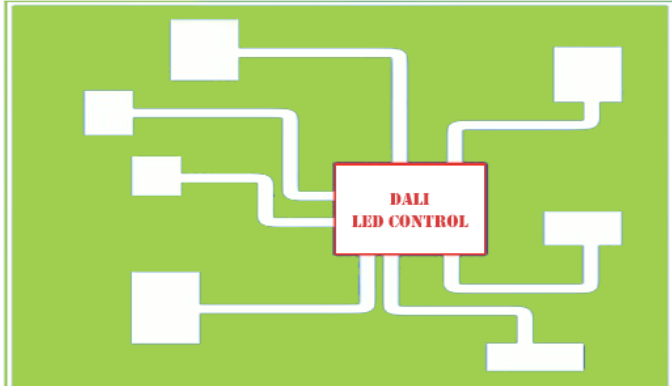Dali and DMX are often compared for comparison, so what is the difference between them?
What is DALI?
DALI stands for Digital Addressable Lighting Interface.
DALI is a two-way digital communication protocol, developed to manage networked lighting-control systems used in building automation projects. A trademarked international standard, DALI enables smooth hassle-free integration of LED gear from diverse manufacturers – equipment that can include dimmable ballasts, receiver and relay modules, power supplies, dimmers/controllers and more.
Originally designed as a successor to 0-10V lighting control, DALI builds on Tridonic’s Digital Serial Interface (DSI) protocol to offer more sophisticated and flexible control. Where traditional 0-10V control provided messaging in one direction only, DALI systems can communicate instructions both ways between the control system and each LED driver and LED ballast / device group.
Fully scalable and ideal for both simple and complex installations, the DALI protocol defines all the commands and communication channels that LED control devices need, in order to fully control building lighting.
Why choose DALI?
If you’re a building designer, owner, electrician, facilities manager or an end-user, then DALI can provide your premises with powerful, adaptable digital lighting control. And you can be confident of no-fuss compatibility with current and future lighting gear from a huge range of suppliers.
For the simplest installations, e.g. single rooms or small buildings, a basic DALI system can be no more than multiple LED fittings connected to a DALI-compatible power supply through a single switch. This kind of set-up requires minimal configuration and eliminates the need for independent control circuits for each fixture.
Larger buildings, office complexes, retail premises, campuses and similar locations will benefit from DALI’s ability to individually address LED ballasts, power supplies and groups of devices, and to easily reconfigure those groupings whenever space and usage requirements change.
What is DMX?
DMX is an acronym for Digital MultipleX.
Offering complete control over their lighting needs to those who use it, DM is a digital, unidirectional protocol. It communicates via a network of shielded cables, wired in twisted pairs (see How do you wire a DMX LED control system? below).
DMX was originally implemented as a means of controlling light dimmers. But since then, its use has widened and advanced, and DMX is now used for all kinds of lighting and other special effects like fog machines and light-rig motion control, as well as complex architectural and interior lighting.
Why choose DMX?
For many designers, artists and even architects, DMX has become the first choice for their lighting system requirements.
And for business owners and entrepreneurs who run big, customer-facing operations such as bars and restaurants, DMX is now recognised as one of the most convenient and practical options, as it allows full control of their lighting needs from a single centralized location.
DALI vs DMX:
Each protocol has its strengths and weaknesses, and the exact same results cannot be achieved with both. The following points may help you in your decision.
Luminaire feedback.
The DALI protocol is bidirectional and includes messages like a lamp or ballast error. Some DMX products support RDM (remote device management) commands for reporting status back to the controller on the DMX cable. In both cases, it is important to verify that both the fixtures and control system support the desired feedback messages.
System integration, user interfaces and wall stations.
DALI offers the ability to connect control devices to the DALI bus and control fixtures directly. This is useful where the desired control logic is relatively simple. DMX/RDM does not typically support additional control devices on the DMX bus, but many controllers can receive input over a separate connection. Control systems are available for both protocols that can offer sophisticated control logic and system integration via a centralised controller.
Fading control.
Fades in DALI are defined within the fixtures using steps, up to a maximum of 90 seconds. Not all DALI fixtures succeed in breaking up the required fade time into a smooth transition. In DMX, fades are determined by the controller, with advanced DMX control systems allowing fades ranging from zero seconds to 24 hours, and supporting 16-bit control for smoother fades (65,535 intensity steps, rather than 255)
Number of scenes.
DALI fixtures support a maximum of 16 scenes. An advanced DALI system can effectively increase this number by remembering extra scenes and sending those to fixtures individually when required, but this results in unsynchronised changes. DMX scenes are stored in the controller, with advanced systems supporting hundreds of scenes.
Emergency lighting.
The DALI protocol, unlike DMX, includes specific emergency lighting functions, including testing and ‘level on signal loss’ features.
Synchronised changes.
The streaming nature of DMX means level changes are always synchronised. With DALI, changes will only be synchronised if they result from the same instruction, for example the recall of previously programmed scenes. However, because of the 16 scene limitation in DALI, many control systems rely on sending individual set-level commands, which will not be synchronised and can create a staggered ‘popcorn’ effect.
Dynamic effects.
DMX allows the colour and intensity of a luminaire to be changed every frame, for example 33 times per second. This means that if your controller can create dynamic effects, such as a wave, fades or subtle sparkles, they will be displayed exactly as intended. The command-based nature of DALI can be very limiting for dynamic effects. You might need to settle for low refresh rates, staggered changes, or accept less control freedom, such as broadcasting to all fixtures.
Daylight harvesting.
Several DALI manufacturers have created systems to fulfil this requirement using sensors connected directly to the DALI bus. Similar results can be achieved with DMX using a controller capable of receiving input from a sensor via a separate cable and processing of this PID loop.
Ease of installation.
DALI is very convenient for installers because all devices and control elements can sit on the same bus, with free typology. DALI is also mains tolerant, and can be installed in the same conduits as the main cabling. A DMX installation does not need to be difficult, but it does require a bit more knowledge, care, and planning, especially if it includes sensors and user interfaces via separate cabling.
Conclusion
There are many aspects where the quality, flexibility and power of the control system are more important than the choice between DMX and DALI. Both protocols can support installations up to many thousands of fixtures. Tuneable white, RGB and other colour fixtures can be supported by both protocols, providing both controller and fixtures support the same modes. Similarly, many control systems can support numerous independent zones of control.






